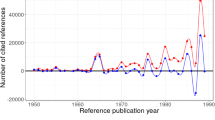Abstract
Density functional theory is the most used methodology in the characterization of the electronic structure of materials. Its applications have spread out to almost every STEM field and it is recognized as one of the most successful theories in materials science. In this paper we measure the specific impact of this theory by means of the citation record of the most important solid-state first principle ab initio packages. We report the exponential growth of publications and how the different electronic structure packages are supporting different scientific communities. Analysis of the growing community, relations between different communities, network strength, relation between citations and number of publications with respect to country of origin of the authors, number of authors per paper, words per title and publication journal is performed. We make several interesting observations, e.g., regarding the connection between the countries where the packages are developed and used, or concerning the collaboration networks. We also find bibliometrical evidence for the specialization of the software packages, even if they include similar capabilities.








Similar content being viewed by others
Data availability
The dataset that supports the findings of this study is available in Figshare with the identifier https://figshare.com/articles/dataset/bibliometric_DFT/12494654/4.
References
Amin, M., & Mabe, M. (2004). Impact factors use and abuse. International Journal of Environmental Science and Technology (IJEST).
Aria, M., & Cuccurullo, C. (2017). bibliometrix: An R-tool for comprehensive science mapping analysis. Journal of Informetrics, 11(4), 959–975. https://doi.org/10.1016/j.joi.2017.08.007.
Arya, C., & Sharma, S. (2011). Authorship trends and collaborative research in veterinary sciences: A bibliometric study. Chinese Librarianship: An International Electronic Journal, 34, 1–9.
Barabási, A.-L., et al. (2002). Evolution of the social network of scientific collaborations. Physica A: Statistical mechanics and its applications, 311(3–4), 590–614.
Bird, S., Klein, E., & Loper, E. (2009). Natural language processing with python. Sebastopol, CA, USA: O’Reilly Media.
Blaha, P., Schwarz, K., Madsen, G.K.H., Kvasnicka, D., Luitz, J., (2001). “wien2k”. In: An augmented plane wave+ local orbitals program for calculating crystal properties.
Chow, D. S., Ha, R., & Filippi, C. G. (2015). Increased rates of authorship in radiology publications: A bibliometric analysis of 142,576 articles published worldwide by radiologists between 1991 and 2012. American Journal of Roentgenology, 204(1), W52–W57.
Deng, B. (2015). “Papers with shorter titles get more citations”. In: Nature News.
Dumaz, M. (2020). pyBilio. https://github.com/romerogroup/pyBiblio.
Garfield, E. (1999). Journal impact factor: a brief review.
Glänzel, W., Schubert, A., & Czerwon, H.-J. (1999). A bibliometric analysis of international scientific cooperation of the European Union (1985–1995). Scientometrics, 45(2), 185–202.
Hagen, N. T. (2008). Harmonic allocation of authorship credit: Source-level correction of bibliometric bias assures accurate publication and citation analysis. PLoS One, 3(12), e4021.
Haunschild, R., Barth, A., & French, B. (2019). A comprehensive analysis of the history of DFT based on the bibliometric method RPYS. Journal of Cheminformatics, 11(1), 72.
Haunschild, R., Barth, A., & Marx, W. (2016). Evolution of DFT studies in view of a scientometric perspective. Journal of cheminformatics, 8(1), 52.
Haunschild, R. & Marx, W. (2020). Discovering seminal works with marker papers. In: Scientometrics, pp. 1–15.
Hirsch, J. E. (2005). An index to quantify an individual’s scientific research output. Proceedings of the National academy of Sciences, 102(46), 16569–16572.
Hohenberg, P., & Kohn, W. (1964). Inhomogeneous electron gas. Physical Review, 136(3B), B864.
Hunter, J. D. (2007). Matplotlib: A 2D graphics environment. Computing in Science and Engineering, 9(3), 90–95.
Kohn, W., & Jeu, S. L. (1965). Self-consistent equations including exchange and correlation effects. Physical Review, 140(4A), A1133.
Larivière, V., et al. (2015). Team size matters: Collaboration and scientific impact since 1900. Journal of the Association for Information Science and Technology, 66(7), 1323–1332.
McCain, K. W., (2014). Obliteration by incorporation. In: Beyond bibliometrics: Harnessing multidimensional indicators of scholarly impact, pp. 129–149
McKinney, W., (2010). Data structures for statistical computing in Python. In: ed. by Stéfan van der Walt and Jarrod Millman, pp. 51–56. https://doi.org/10.25080/Majora-92bf1922-00a.
Moed, H. F. (2006). Citation analysis in research evaluation (Vol. 9). Berlin, Germany: Springer Science & Business Media.
Oliphant, T. E. (2006). A guide to NumPy. USA: Trelgol Publishing.
Perdew, J. P., Burke, K., & Ernzerhof, M. (1996). Generalized gradient approximation made simple. Physical review letters, 77(18), 3865.
Peters, H., & Van Raan, A. (1991). Structuring scientific activities by co-author analysis: An exercise on a university faculty level. Scientometrics, 20(1), 235–255.
SCImago, . (2007). SJR-SCImago Journal & Country Rank.
Stéfan van der Walt, S., Colbert, C., & Varoquaux, G. (2011). The NumPy array: A structure for efficient numerical computation. Computing in Science and Engineering, 13(2), 22–30.
Noorden, V., Richard, B. M., & Nuzzo, R. (2014). The top 100 papers. Nature News, 514(7524), 550.
Author information
Authors and Affiliations
Contributions
Marie Dumaz and Reese Boucher downloaded the data from the Web of Science database and created the corresponding packages for data cleaning and data analysis. Marie Dumaz, Miguel A.L. Marques and Aldo H. Romero did the data analysis, created the data figures and wrote the paper.
Corresponding author
Ethics declarations
Conflict of interests
The authors declare that they have no conflict of interest.
Additional information
This work was supported by NSF SI2-SSE Grant 1740112, DMREF-NSF 1434897, DOE DE-SC0016176 and DE-SC0019491 grants.
Supplementary Information
Below is the link to the electronic supplementary material.
Rights and permissions
About this article
Cite this article
Dumaz, M., Boucher, R., Marques, M.A.L. et al. Authorship and citation cultural nature in Density Functional Theory from solid state computational packages. Scientometrics 126, 6681–6695 (2021). https://doi.org/10.1007/s11192-021-04057-z
Received:
Accepted:
Published:
Issue Date:
DOI: https://doi.org/10.1007/s11192-021-04057-z




